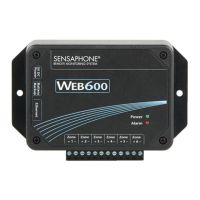42
WEB600 User’s Manual
Quick Access Table
The following is a quick access table to retrieve the word-access, read-only current input values
as human-readable ASCII strings. Use the Modbus® command “4” to access the data.
Address Description
3x01552 Zone 1
3x01594 Zone 2
3x01636 Zone 3
3x01678 Zone 4
3x01720 Zone 5
3x01762 Zone 6
3x01846 Power
3x01888 Battery
MODBUS® DATA FORMATS
Bit-Representation
The Modbus® interface supports a programmable bit ordering. Both the byte- and word-orders may be individually
programmed to either little- or big-endian formats. The default is big-endian byte-order and little-endian word-
order. This only applies to numeric values. Array, string and bit types are always given in the same format.
Bit
Bit values are boolean values where 1 is “true” and 0 is “false”.
uint8, sint16, uint32, sint32
These are integer data formats. The “u” stands for “unsigned”, the “s” stands for “signed”. The number
indicates the number of bits used to represent the data: 8, 16, or 32 corresponding to 1, 2, or 4 bytes
respectively. 1 and 2 byte integers are stored in one Modbus® register while 4-byte integers are stored
in two consecutive Modbus® registers. The byte- and word-orders are programmable.
The integer types may be either fixed-point format or the standard straight integer format. Fixed-
point integer formats are offset by “100”, so divide the straight binary value by “100” to get the real
value. This provides 2 decimal places of precision for a maximum range of ±80000.00.
Float
This is a standard IEEE 754 32-bit floating-point number. All floating-point numbers will be in this format
and span 2 consecutive Modbus® registers according to the programmed byte- and word-orders.
String and array
Strings and arrays are strings of 0 or more characters/bytes. They are always returned first-
byte first and last-byte
last. Strings are null-terminated with a binary 0 only if they are smaller than their maximum size. For example,
a “name” string may be up to 32-characters long. A value of “John Doe” would be terminated by a “0” because
it is less than 32-characters long, but not a name that is 32-characters long. Arrays are never terminated.

